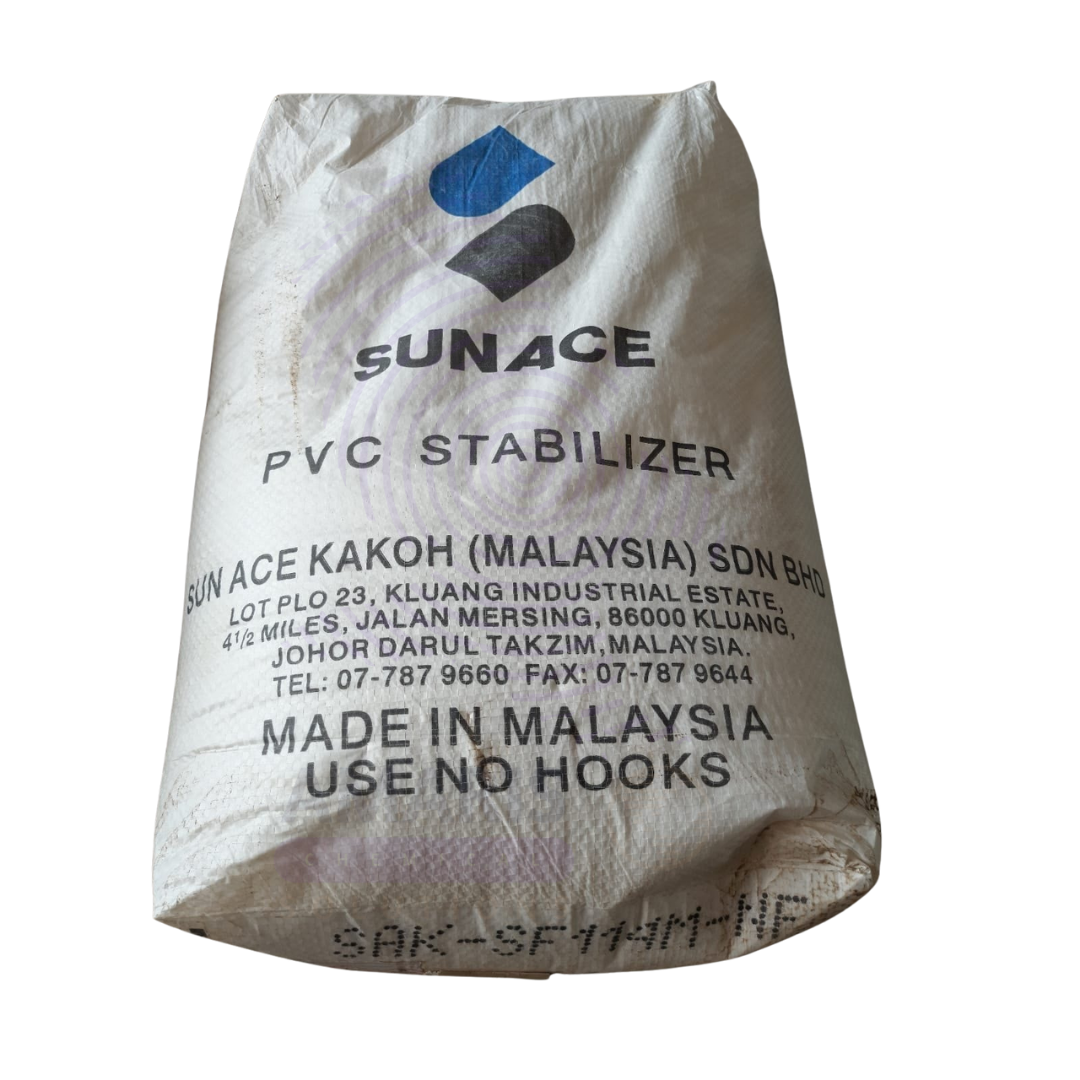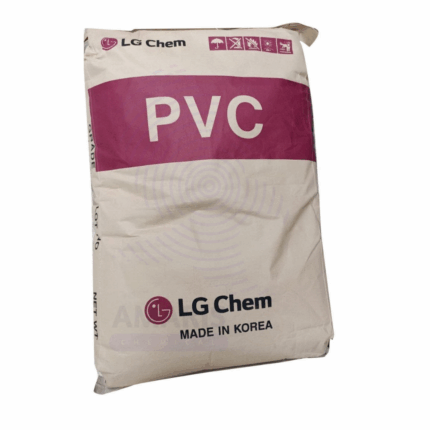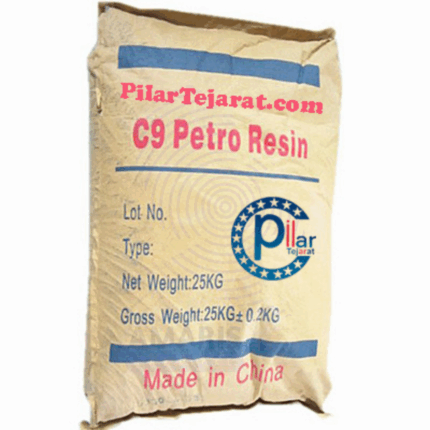PVC Stabilizer
PVC Stabilizer is a crucial additive used in the processing of polyvinyl chloride (PVC) to protect it from thermal degradation during manufacturing and throughout its service life. It ensures color stability, prevents chain scission, and enhances the durability of PVC products exposed to heat, light, and mechanical stress. PVC stabilizers are available in various types, including lead-based, calcium-zinc (Ca-Zn), organotin, and mixed metal stabilizers, each suited for different applications depending on regulatory, environmental, and performance requirements.
PVC Stabilizer
Primary Uses
PVC Pipe and Fitting Manufacturing
Prevents discoloration and degradation of rigid PVC during high-temperature extrusion and molding.
Enhances long-term thermal and mechanical stability in pressure and drainage pipe systems.
Window and Door Profiles
Provides UV and heat resistance in exterior PVC profiles used in construction.
Ensures weatherability and color retention over extended exposure to sunlight.
Cable and Wire Sheathing
Used in flexible PVC for electrical insulation and sheathing to resist thermal degradation.
Maintains electrical properties and plasticity under heat from electrical currents.
Rigid and Flexible Films
Stabilizes calendared PVC films used in packaging, stationery, and decorative applications.
Prevents fogging, discoloration, and embrittlement in clear and colored films.
Synthetic Leather and Flooring
Ensures flexible PVC materials maintain surface finish and mechanical strength under heat and stress.
Prevents brittleness and cracking over time in coated fabrics and flooring tiles.
Injection Molding
Supports processing of PVC in molded applications such as fittings, containers, and caps.
Helps maintain gloss, color, and dimensional stability during thermal cycling.
Secondary Uses
Medical Devices (with Non-toxic Grades)
Used in the production of IV tubes, blood bags, and medical films where non-toxic Ca-Zn or organotin stabilizers are required.
Toys and Childcare Products
Utilized in soft PVC toys and baby care goods with non-lead stabilizers compliant with safety standards.
Automotive Interiors
Provides long-term color stability and thermal resistance in PVC dashboards, door panels, and trims.
Adhesives & Sealants
Incorporated into PVC-based adhesives to maintain stability under heat curing or prolonged use.
Tarpaulins, Coated Fabrics, and Tents
Ensures mechanical strength and UV resistance in outdoor fabric coatings.
Ink & Paint Formulations (PVC-based)
Helps maintain clarity and viscosity control in formulations that involve PVC resins and need thermal resistance.
Basic Identification Attributes
Chemical Name (IUPAC): Varies by type (e.g., calcium-zinc carboxylates, dibutyltin maleate, lead stearate)
Common/Trade Name: PVC Stabilizer
CAS Number: Varies depending on composition
HS Code: 3812.30.00
Synonyms: Heat stabilizer; thermal stabilizer for PVC; PVC processing aid
Physical & Chemical Properties
Physical State: Powder, flakes, granules, or liquid depending on formulation
Color & Odor: White/off-white (solid) or colorless (liquid); slight to no odor
Solubility: Insoluble in water; dispersible in plasticizers or solvents
Melting Point: Varies; typically above 100°C for solids
Density: 1.0 – 1.5 g/cm³ depending on formulation
Safety & Hazard Attributes
GHS Classification: Varies—some types may be hazardous (e.g., lead-based); others non-toxic (e.g., Ca-Zn)
Toxicity: Depends on composition; non-toxic grades available for sensitive applications
Exposure Limits: Follow safety data sheets and local exposure regulations
Storage & Handling Attributes
Storage Conditions: Store in original, tightly closed containers in a dry, cool area away from moisture and heat sources
Container Type: 25 kg bags, drums, or intermediate bulk containers (IBCs)
Shelf Life: 12–24 months under proper storage conditions
Handling Precautions: Avoid inhalation of dust or vapors; use dust extraction and protective equipment
Regulatory & Compliance Attributes
Non-toxic types (Ca-Zn, organotin) may comply with FDA, EU (REACH), and RoHS standards
Lead-based stabilizers are restricted or banned in many regions for consumer or food contact products
Produced under ISO 9001 or GMP-certified systems for specialty applications
Environmental & Health Impact
Biodegradability: Not biodegradable
Ecotoxicity: Lead and cadmium-based stabilizers are toxic; Ca-Zn and organotin grades have low ecological impact
Bioaccumulation: Minimal for most modern stabilizers; legacy types may pose long-term risks
PPE Required: Safety goggles, gloves, dust mask or respirator, protective clothing
Handling Guidelines: Ensure good ventilation; avoid generating dust; use grounded equipment when transferring powders
Storage Measures: Keep containers tightly closed and stored in a dry environment
First Aid Measures
Inhalation: Move to fresh air; seek medical attention if breathing becomes difficult
Skin Contact: Wash with soap and water; seek medical advice if irritation occurs
Eye Contact: Rinse thoroughly with water for 15 minutes; consult medical help if irritation persists
Ingestion: Rinse mouth; do not induce vomiting; seek immediate medical assistance
Firefighting Measures
Fire Hazards: Most types are not highly flammable; some may emit toxic fumes when decomposed
Extinguishing Media: Use dry chemical, foam, CO₂, or water spray
Special Precautions: Use self-contained breathing apparatus and protective clothing
Hazardous Combustion Products: Hydrogen chloride, carbon monoxide, metal oxides


 Preservatives(food)
Preservatives(food) Flavor Enhancers
Flavor Enhancers Acidulants
Acidulants Sweeteners
Sweeteners Antioxidants
Antioxidants Colorants(food)
Colorants(food) Nutraceutical Ingredients (food)
Nutraceutical Ingredients (food) Nutrient Supplements
Nutrient Supplements Emulsifiers
Emulsifiers
 Collectors
Collectors Dust Suppressants
Dust Suppressants Explosives and Blasting Agents
Explosives and Blasting Agents Flocculants and Coagulants
Flocculants and Coagulants Frothers
Frothers Leaching Agents
Leaching Agents pH Modifiers
pH Modifiers Precious Metal Extraction Agents
Precious Metal Extraction Agents
 Antioxidants(plastic)
Antioxidants(plastic) Colorants (Pigments, Dyes)
Colorants (Pigments, Dyes) Fillers and Reinforcements
Fillers and Reinforcements Flame Retardants
Flame Retardants Monomers
Monomers Plasticizers
Plasticizers Polymerization Initiators
Polymerization Initiators Stabilizers (UV, Heat)
Stabilizers (UV, Heat)
 Antifoaming Agents
Antifoaming Agents Chelating Agents
Chelating Agents Coagulants and Flocculants
Coagulants and Flocculants Corrosion Inhibitors
Corrosion Inhibitors Disinfectants and Biocides
Disinfectants and Biocides Oxidizing Agents
Oxidizing Agents pH Adjusters
pH Adjusters Scale Inhibitors( water)
Scale Inhibitors( water)
 Antioxidants(cosmetic)
Antioxidants(cosmetic) Emollients
Emollients Fragrances and Essential Oils
Fragrances and Essential Oils Humectants
Humectants Preservatives
Preservatives Surfactants(cosmetic)
Surfactants(cosmetic) Thickeners
Thickeners UV Filters
UV Filters
 Fertilizers
Fertilizers Soil Conditioners
Soil Conditioners Plant Growth Regulators
Plant Growth Regulators Animal Feed Additives
Animal Feed Additives Biostimulants
Biostimulants Pesticides (Herbicides, Insecticides, Fungicides)
Pesticides (Herbicides, Insecticides, Fungicides)
 Active Pharmaceutical Ingredients (APIs)
Active Pharmaceutical Ingredients (APIs) Excipients
Excipients Solvents(pharmaceutical)
Solvents(pharmaceutical) Antibiotics
Antibiotics Antiseptics and Disinfectants
Antiseptics and Disinfectants Vaccine Adjuvants
Vaccine Adjuvants Nutraceutical Ingredients (pharmaceutical)
Nutraceutical Ingredients (pharmaceutical) Analgesics & Antipyretics
Analgesics & Antipyretics
 Analytical Reagents
Analytical Reagents Solvents(lab)
Solvents(lab) Chromatography Chemicals
Chromatography Chemicals Spectroscopy Reagents
Spectroscopy Reagents microbiology-and-cell-culture-reagents
microbiology-and-cell-culture-reagents Molecular Biology Reagents
Molecular Biology Reagents Biochemical Reagents
Biochemical Reagents Inorganic and Organic Standards
Inorganic and Organic Standards Laboratory Safety Chemicals
Laboratory Safety Chemicals Specialty Laboratory Chemicals(Special Laboratory Equipment)
Specialty Laboratory Chemicals(Special Laboratory Equipment)
 Demulsifiers
Demulsifiers Hydraulic Fracturing Fluids
Hydraulic Fracturing Fluids Scale Inhibitors(oil)
Scale Inhibitors(oil) Surfactants(oil)
Surfactants(oil) Drilling Fluids
Drilling Fluids
 Dyes and Pigments
Dyes and Pigments Bleaching Agents
Bleaching Agents Softening Agents
Softening Agents Finishing Agents
Finishing Agents Antistatic Agents
Antistatic Agents
 Admixtures
Admixtures Waterproofing Agents
Waterproofing Agents Sealants and Adhesives
Sealants and Adhesives Curing Compounds
Curing Compounds Concrete Repair Chemicals
Concrete Repair Chemicals Anti-Corrosion Coatings
Anti-Corrosion Coatings
 Surfactants(cleaning)
Surfactants(cleaning) Builders
Builders Enzymes
Enzymes Solvents (Cleaning)
Solvents (Cleaning) Fragrances
Fragrances
 Electronic Chemicals
Electronic Chemicals Catalysts
Catalysts Lubricants
Lubricants Photographic Chemicals
Photographic Chemicals Refrigerants
Refrigerants Automotive chemicals
Automotive chemicals Pyrotechnic Chemicals
Pyrotechnic Chemicals
 Biodegradable Surfactants
Biodegradable Surfactants Bio-based Solvents
Bio-based Solvents Renewable Polymers
Renewable Polymers Carbon Capture Chemicals
Carbon Capture Chemicals Wastewater Treatment Chemicals
Wastewater Treatment Chemicals
 Pigments
Pigments Solvents(paint)
Solvents(paint) Specialty Coatings
Specialty Coatings Binders/Resins
Binders/Resins Additives
Additives Driers
Driers Anti-Corrosion Agents
Anti-Corrosion Agents Functional Coatings
Functional Coatings Application-Specific Coatings
Application-Specific Coatings
 Fresh Herbs
Fresh Herbs Ground Spices
Ground Spices Whole Spices
Whole Spices Spice Blends
Spice Blends Dried Herbs
Dried Herbs
 Leavening Agents
Leavening Agents Dough Conditioners
Dough Conditioners Flour Treatments
Flour Treatments Fat Replacers
Fat Replacers Decoratives
Decoratives Preservatives(baking)
Preservatives(baking)
 Plasticizers & Softeners
Plasticizers & Softeners Reinforcing Agents
Reinforcing Agents Adhesion Promoters
Adhesion Promoters Vulcanizing Agents
Vulcanizing Agents Antidegradants
Antidegradants Blowing Agents
Blowing Agents Fillers & Extenders
Fillers & Extenders Accelerators & Retarders
Accelerators & Retarders





















